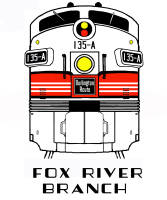Page 4
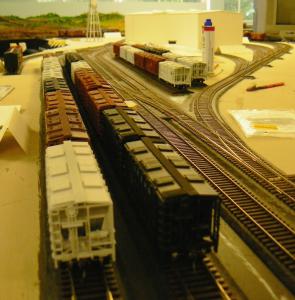 There aren’t many (actually, only one) photos of the Ottawa portion of the layout here, as it has very little scenery completed. Here’s the one shot I took , an overview of the “Seiberling Lead”, the joint RI-CB&Q industrial lead on Ottawa’s west side. The covered hoppers at left are spotted at Ottawa Silica for bulk sand loading, the tracks and mock-up building to the right represent the Libby-Owens-Ford glass plant. Beyond the water tower in the distance is the Rock Island’s Ottawa yard. The hills on the backdrop are actually across the aisle, but similar bluffs do exist in this part of Ottawa.
There aren’t many (actually, only one) photos of the Ottawa portion of the layout here, as it has very little scenery completed. Here’s the one shot I took , an overview of the “Seiberling Lead”, the joint RI-CB&Q industrial lead on Ottawa’s west side. The covered hoppers at left are spotted at Ottawa Silica for bulk sand loading, the tracks and mock-up building to the right represent the Libby-Owens-Ford glass plant. Beyond the water tower in the distance is the Rock Island’s Ottawa yard. The hills on the backdrop are actually across the aisle, but similar bluffs do exist in this part of Ottawa.
When Ottawa is done it will be quite remarkable as it will include a nearly full-size representation (all four spans) of the drawbridge over the Illinois River that will be the first thing you see as you climb the stairs into the layout room. Ottawa also features an extensive operating Rock Island presence, as both roads switch Ottawa Silica and Libby-Owens-Ford via the Seiberling Lead.
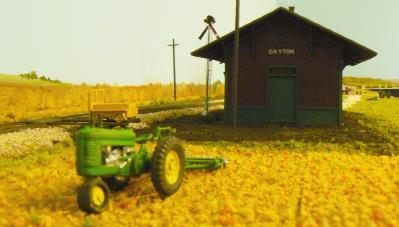 Ottawa keeps three operators busy, with one operating the RI (switch job and running pickup/setout trains to and from staging) and two on the Q (the Ottawa switch job and the “Roustabout”, which also switches in Ottawa and works up to Wedron and return).
Ottawa keeps three operators busy, with one operating the RI (switch job and running pickup/setout trains to and from staging) and two on the Q (the Ottawa switch job and the “Roustabout”, which also switches in Ottawa and works up to Wedron and return).
Here is the depot at Dayton, IL just north of Ottawa. While the depot is a faithful representation, the real Dayton is much more wooded and hilly than this, but when you have a bunch of native Texans working on your scenery (for free!), they tend to build what they know, which is flat and arid. Eric plans on revisiting this portion of the layout and conducting a “re-forestation” makeover once the major unfinished portions of the layout (Ottawa and Wedron) are in.
While we’re on the topic of faithful representation, we should note that Eric’s trackplan was based on the CB&Q’s track diagrams for the line. While space limitations did not permit modeling every town or a completely faithful representation, in several locations (like downtown Ottawa and Streator), the track arrangements are extremely faithful to the prototype. In the town of Wedron, the track arrangement is drawn from the CB&Q diagrams, but is “flipped” (i.e., a mirror image) from the prototype, to allow the large Wedron Silica Co. complex to be located along the backdrop.
Perhaps the most noticeable omission was Burgess Jct., where the branch line to Baker and Earlville (on the Chicago-Galesburg main) met the Streator line. Burgess Jct. had to go not only because there was not enough room between Wedron and Sheridan to fit it in, but also because the track arrangement would have had the wye jutting out into the aisle.
The omission of Burgess Jct. had one repercussion on the operating scheme: In 1954, the real Roustabout was a wayfreight that worked between Ottawa and Mendota via Burgess Jct., then northwesterly on the branch through Baker and Earlville to Mendota.
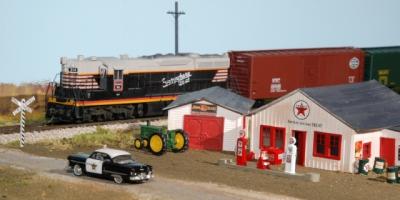 With no Burgess Jct. or line to Earlville, Eric’s Roustabout assists the Ottawa yard job with additional switching at Ottawa’s North Yard, then works a turn to Wedron where it switches the Wedron Silica plant and exchanges cars with the “Fox River Wayfreight”, an Eola (Aurora)-Wedron turn. Your author worked the Roustabout during his visit and had such a good time I forgot to take any photos! Fortunately, Eric had some photos from previous sessions when the same “motor”, SD7 # 314, was assigned:
With no Burgess Jct. or line to Earlville, Eric’s Roustabout assists the Ottawa yard job with additional switching at Ottawa’s North Yard, then works a turn to Wedron where it switches the Wedron Silica plant and exchanges cars with the “Fox River Wayfreight”, an Eola (Aurora)-Wedron turn. Your author worked the Roustabout during his visit and had such a good time I forgot to take any photos! Fortunately, Eric had some photos from previous sessions when the same “motor”, SD7 # 314, was assigned:
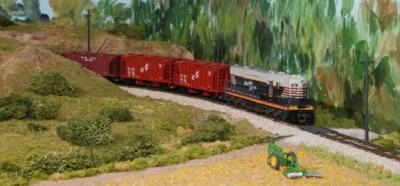 Extra 314 North (The Roustabout) enters the south edge of Dayton, IL on its way to Wedron. (Two photos this page courtesy of Eric Mumper)
Extra 314 North (The Roustabout) enters the south edge of Dayton, IL on its way to Wedron. (Two photos this page courtesy of Eric Mumper)
On another day, 314 has the Roustabout southbound leaving Wedron. While Wedron loading routed via Eola moves on the Fox River Wayfreight, other cars (cars bound for Chicago connections via Cicero as well as cars for Ottawa and Streator) are handled by the Roustabout to Ottawa for switching either to the Rock Island or blocked into the pickups for Cicero-Streator trains 85 and 86. This permits Train 86 to avoid stopping at Wedron to pick up before tackling the ruling grade just north of town.
